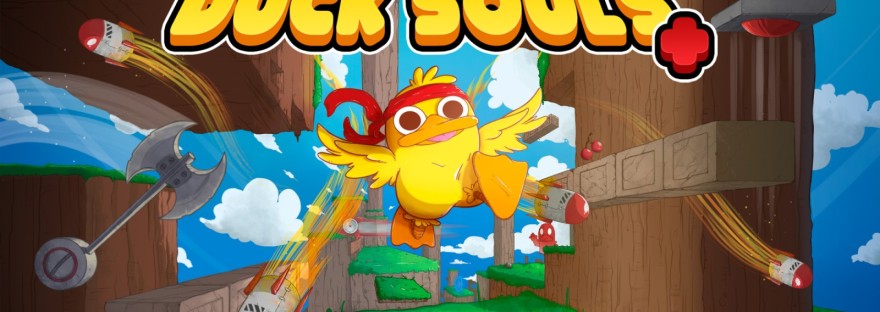Things aren’t quite what you expect them to be with Duck Souls+
If you’re judging by its title, you probably expect roguelike mechanics, clumsy control mechanics, a lot of atmosphere and punishing enemies at every turn. If you take a look at screenshots then maybe you’re thinking a cute little one screen puzzle platformer.
That last one is close to the truth, its also misleading. Yes, Duck Souls+ is cute, its brightly coloured and fun to look at, its also a one-screen puzzle platformer, but don’t let that fool you into thinking its easy as its anything but.
Unsurprisingly you play through the game as a duck, challenged with retrieving the lost duck souls or something to that effect, the plots only really referenced very early on and isn’t important to what follows. Once that little intro sequence is done with you’re plonked on a full-screen level and challenged with getting from one point to the other before being allowed to move onto the next one. As you progress more challenges are thrown in your way. You’re then given a few levels to get used to each new obstacle, first on its own and then mixed with other obstacles you’ve previously had to learn.
Thankfully Duck Souls+ realises that we’re all at differing levels of skill, with developers Green Dinosaur Games providing two difficulty levels, Normal and Hard, the main difference being the former gives you well-placed checkpoints in levels allowing the player to take a breather and figure out the next step without worrying that a mistake will see you sent right back tot he beginning of the level. However, the beautiful thing is, you can drop out and change the difficulty level at will without there being any gateway preventing you from progressing if you choose to chop and change between either of them. Add in that the levels never really outstay their welcome and you have a short sharp, entertaining little game that’s perfect for both long gaming sessions and just picking up and playing.
It’s that last point that I’d like to build on a little. I played the PSN version of the game, which is compatible with both PS4 and Vita, and whilst there’s no Cross-Save feature here, meaning you have to play through each installation individually rather than being able to switch between the two at will (a feature that the Switch version benefits from due to it being one system with two methods of playing it rather than two separate consoles). I tried it on both systems and personally found the more confined screen but smaller controls felt much more accurate than playing it on the households main TV using a Dual Shock 4, in fact, the Vita’s d-pad is absolutely perfect for this game, add in the systems sleep function and I found myself picking it up and playing it in little fits and starts rather than the more dedicated time I tend to have with the PS4.
The games price point is definitely worth a mention, at £4 on the PlayStation Store, its ridiculously cheap, the budget pricing gives the impression that its a budget game, but it genuinely feels anything but. the presentation is nice and a lot of care and thought has gone into the level design, decisions such as the interchangeable difficulty level sitting alongside this price point does make it slightly disposable, but there’s also far less pressure on the player to just “Git Gud!”
Formats: Nintendo Switch, PlayStation 4 (version tested), Xbox One, Microsoft Windows, PlayStation Vita (version tested)
Release Date: September 8 2019 (Steam), April 2020 (Other Systems)
Publisher: Ratalaika Games
Developer: Green Dinosaur Games





